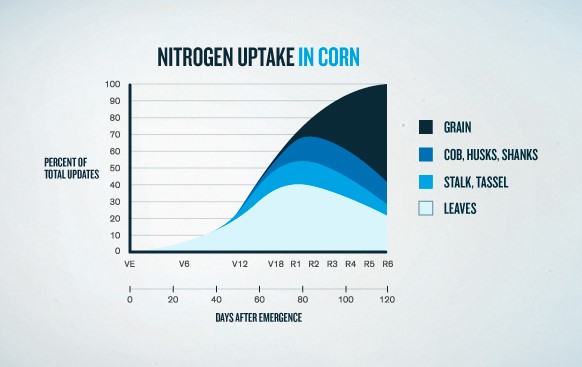Get your farmers ready to sidedress. According to the National Weather Service Climate Prediction Center, farmers may be in for a wetter than average spring across the Corn Belt. Growers in Minnesota, much of Iowa, Indiana and states in the Northeast could be most affected, based on National Weather Service predictions. If the predictions come to fruition, your customers could face challenges getting early season nitrogen fertilizer applications completed. In that scenario, farmers may need to be prepared to apply supplemental nitrogen via sidedress application method.
Sidedressing Successfully
While much of successful sidedressing is in the art of balancing the ability to best get nitrogen applied with minimizing crop damage and subsequent adverse yield impact, another major component is being able to keep the nitrogen available for the crop after it’s applied and have it remain in the root zone during critical uptake growth stages.

Unique Challenges
A challenge with sidedress is that the timing of the application often coincides with weather conditions that are most conducive to leaching. Wet soil, standing water and visible deficiencies in some plants indicate nitrogen is likely leaching and on the move away from the root zone. Consider these facts specific to leaching during wet weather conditions:
- Urea moves one foot per inch of rain in sandy and heavily tile-drained soils.1
- Water-saturated soils can lose as much as 5 percent of nitrate nitrogen per day when temperatures are warm.1
Stabilization Benefits
Instinct® and N-Serve® nitrogen stabilizers maximize nitrogen so corn crops deliver the max in return by protecting against leaching and denitrification. They work underground, where up to 70 percent of nitrogen loss can occur.
“What N-Serve does is stops nitrogen from converting to a leachable form. So, we truly buy time with N-Serve — typically six to eight weeks of protection from rains and leaching.”
— Brian Kruse, agronomist, Farmers Feed and Grain Company Inc., Iowa.
Application Tips

1Fernandez, F. G., D. Kaiser, and J. Vetsch. 2015. Nitrogen Management: Considerations for Sidedressing.
2Sawyer, J. 2014. Nitrogen Applications: Sidedress it Right. https://www.agweb.com/article/nitrogen_applications_sidedress_it_right_naa_university_news_release/
®™ Trademark of The Dow Chemical Company (“Dow”) or E. I. du Pont de Nemours and Company (“DuPont”) or affiliated companies of Dow or DuPont. Instinct is not registered for sale or use in all states. Contact your state pesticide regulatory agency to determine if a product is registered for sale or use in your state. Do not fall-apply anhydrous ammonia south of Highway 16 in the state of Illinois. Always read and follow label directions. ©2018 Dow AgroSciences LLC

